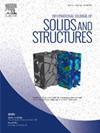Free vibration of electroelastic thin-walled structures under static load
IF 3.4
3区 工程技术
Q1 MECHANICS
International Journal of Solids and Structures
Pub Date : 2024-10-29
DOI:10.1016/j.ijsolstr.2024.113123
引用次数: 0
Abstract
The mathematical formulation and finite element algorithm for solving the problem of free vibration of electroelastic plates and shells under static load are considered. In modeling, the curvilinear surface of a thin-walled structure is represented as a set of flat segments. In each of them, the physical relations of the classical laminated plate theory and the theory of electroelasticity, written for a plane stress state, are fulfilled. The strains are determined using nonlinear equations, which are linearized with respect to the state with a small deviation from the initial equilibrium position caused by static forces. As an examples, we consider a rectangular plate and a circular cylindrical shell with a piezoelectric element under the action of the uniform pressure. The validity of the solution is confirmed by comparing the normal displacement and natural frequencies of vibration with experimental data and results obtained with the use of commercial finite element software.
静载荷下电弹性薄壁结构的自由振动
研究了解决静载荷下电弹性板和壳自由振动问题的数学公式和有限元算法。在建模过程中,薄壁结构的曲线表面表示为一组平面段。在每个片段中,经典层压板理论和电弹性理论的物理关系都是针对平面应力状态编写的。应变是通过非线性方程确定的,而非线性方程是针对静力导致的与初始平衡位置有微小偏差的状态线性化的。作为示例,我们考虑了在均匀压力作用下带有压电元件的矩形板和圆形圆柱壳。通过将法向位移和振动的自然频率与实验数据和使用商业有限元软件获得的结果进行比较,证实了该解决方案的有效性。
本文章由计算机程序翻译,如有差异,请以英文原文为准。
求助全文
约1分钟内获得全文
求助全文
来源期刊
CiteScore
6.70
自引率
8.30%
发文量
405
审稿时长
70 days
期刊介绍:
The International Journal of Solids and Structures has as its objective the publication and dissemination of original research in Mechanics of Solids and Structures as a field of Applied Science and Engineering. It fosters thus the exchange of ideas among workers in different parts of the world and also among workers who emphasize different aspects of the foundations and applications of the field.
Standing as it does at the cross-roads of Materials Science, Life Sciences, Mathematics, Physics and Engineering Design, the Mechanics of Solids and Structures is experiencing considerable growth as a result of recent technological advances. The Journal, by providing an international medium of communication, is encouraging this growth and is encompassing all aspects of the field from the more classical problems of structural analysis to mechanics of solids continually interacting with other media and including fracture, flow, wave propagation, heat transfer, thermal effects in solids, optimum design methods, model analysis, structural topology and numerical techniques. Interest extends to both inorganic and organic solids and structures.

 求助内容:
求助内容: 应助结果提醒方式:
应助结果提醒方式:


